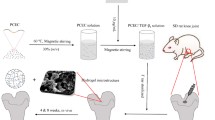Abstract
Injectable hydrogel provides a new advance on lubrication of artificial joints due to its in situ forming property and long-term release effect. The adaptability improvement of the injectable hydrogel is crucial for its successful application in joint prostheses without weakening its injectable performance. In this paper, we reported a thermosensitive poly(ε-caprolactone)-poly(ethylene glycol)-poly(ε-caprolactone) (PCEC) hydrogel embedded with carbon nanotubes (CNT) to improve its shear resistance and strain resistance. The phase-transition test demonstrated that the temperature range at the gel state for the PCEC/CNT hydrogel is higher than that of PCEC hydrogel under identical condition. We also demonstrated the CNT enhance the viscoelasticity of the thermosensitive PCEC hydrogel under the premise of retaining the effective slow-release behavior of bull serum albumin. The PCEC/CNT composite hydrogel has excellent slow-release and release-lubrication effects while maintaining its injectability. Consequently, it shows a promising application prospect as an injectable carrier, which provides slow-release lubrication effect on artificial joints.














Similar content being viewed by others
References
Cheng X, Cheng G, Xing X et al (2020) Controlled release of adenosine from core-shell nanofibers to promote bone regeneration through stat3 signaling pathway. J Control Release 319:234–245
Wang Y, Li Z, Ouyang J et al (2020) Controlled release of entrapped nanoparticles from thermoresponsive hydrogels with tunable network characteristics. Soft Matter 16(20):4756–4766
Ma SH, Scaraggi M, Lin P et al (2017) Nanohydrogel brushes for switchable underwater adhesion. J Phys Chem C 121(15):8452–8463
Eltom A, Zhong GY (2019) Muhammad A. Scaffold techniques and designs in tissue engineering functions and purposes: A review Adv Mater Sci Eng 283 1687–8434
Mangir N, Eke G, Hasirci N et al (2019) An estradiol releasing, proangiogenic hydrogel as a candidate material for use in soft tissue interposition. Neurourol Urodynam 38(5):1195–1202
Shen J, Chang L, Chen D et al (2021) Cross-linking induced thermo-responsive self-healing hydrogel with gel-sol–gel transition constructed on dynamic covalent bond[J]. J Polym Res 28(4):132
Zheng SJ, Li ZQ, Liu ZS (2019) The inhomogeneous diffusion of chemically crosslinked polyacrylamide hydrogel based on poroviscosity theory. Sci China Technol Sc 62(8):1375–1384
Yousef P, Marziyeh F, Yadollah O et al (2020) Synthesis and characterization of timolol maleate-loaded quaternized chitosan-based thermosensitive hydrogel: A transparent topical ocular delivery system for the treatment of glaucoma. Int J Biol Macromol 159:117–128
Wu N, Yu H, Sun M et al (2020) Investigation on the structure and mechanical properties of highly tunable elastomeric silk fibroin hydrogels cross-linked by γ-ray radiation. ACS Appl Bio Mater 3(1):721–734
Oveissi F, Naficy S, Le TYL et al (2019) Tough hydrophilic polyurethane-based hydrogels with mechanical properties similar to human soft tissues. J Mater Chem B 7(22):3512–3519
Guo J, Li Y, Lu H et al (2018) PCEC hydrogel used on sustained-release hyaluronic acid delivery with lubrication effect. J Appl Polym Sci 135(22):46228
Paradiso P, Serro AP, Saramago B et al (2016) Controlled release of antibiotics from vitamin e-loaded silicone-hydrogel contact lenses. J Pharm Sci 105(3):1164–1172
Guo JD, Li Y, Li Y et al (2017) Biotribological application of poly(epsilon-caprolactone)-poly(ethylene glycol)-poly(epsilon-caprolactone) hydrogel as an efficient carrier with slow-release lubrication effect. J Mater Sci 52(20):12054–12066
Huang YC, Lee CT, Don TM (2021) Physicochemical characteristics of thermo-responsive gelatin membranes containing carboxymethyl chitosan and poly(N -isopropylacrylamide-co-acrylic acid)[J]. J Polym Res 28(5):1–13
Sayadnia S, Arkan E, Jahanban-Esfahlan R et al (2021) Thermal-responsive magnetic hydrogels based on Tragacanth gum for delivery of anticancer drugs[J]. J Polym Res 28(3):90
Almomen A, Cho S, Yang CH et al (2015) Thermosensitive progesterone hydrogel: A safe and effective new formulation for vaginal application. Pharm Res-Dordr 32(7):2266–2279
Guo J, Mei T, Li Y et al (2018) One-pot synthesis and lubricity of fluorescent carbon dots applied on pcl-peg-pcl hydrogel. J Biomater Science-polymer Edition 29(13):1549–1565
Li XW, Shi T, Li B et al (2019) Subtractive manufacturing of stable hierarchical micro-nano structures on aa5052 sheet with enhanced water repellence and durable corrosion resistance. Mater Design 183:108152
Zhang H, Liu Y, Hafezi M et al (2020) A distribution design for circular concave textures on sectorial thrust bearing pads. Tribol Int 149
Lee S, Yoon HW, Lee DY (2007) Carbon nanotube/nafion composites for biomimetic artificial muscle actuators. J Korean Ceram Soc 44(4):198–201
Guo JD, Mei TJ, Li Y et al (2018) Sustained-release application of pcec hydrogel on laser-textured surface lubrication. Mater Res Express 5(6): 065315
Zhang Q, Liu Y, Ling HU et al (2008) Synthesis of thin-walled carbon nanotubes from methane by changing the ni/mo ratio in a ni/mo/mgo catalyst. New Carbon Mater 23(4):319–325
Tong Z, Ma Q, Ni YQ et al (2019) Tribological properties of carbon fabric reinforced phenolic-based composites containing cnts@mos2 hybrids. J Mater Sci 54(23):14354–14366
Ivanov AN (2012) Ultrasonic dispersion of Al–AlN and Al2O3 nanopowder agglomerates and of nanostructured AlOOH particles[J]. Russ Phys J 54(12):1413–1417
Sauter C, Emin MA, Schuchmann HP et al (2008) Influence of hydrostatic pressure and sound amplitude on the ultrasound induced dispersion and de-agglomeration of nanoparticles[J]. Ultrason Sonochem 15(4):517–523
S B, K KY, D T (2000) Unusually high thermal conductivity of carbon nanotubes. Physical Review Letters 84(20): 4613–4616
Peng Y , Hu Y , Wang H (2007) Tribological behaviors of surfactant-functionalized carbon nanotubes as lubricant additive in water[J]. Tribology Letters 25(3):247–253)
Li XF, Yan H, Peng SX (2011) Colloidal Polystyrene-Carbon Nanotubes as Water-Based Lubricant Additive[J]. Advanced Materials Research 228–229:253–258
Funding
This work was supported by Special Research Project in Shaanxi Province Department of Education (20JK0668); The Project National United Engineering Laboratory for Advanced Bearing Tribology (202106); Science and Technology on Diesel Engine Turbocharging Laboratory (6142212190104) and Innovation Capability Support Program of Shaanxi (2020KJXX-016).
Author information
Authors and Affiliations
Corresponding author
Ethics declarations
Conflict of interest
The authors declare that they have no conflict of interest.
Additional information
Publisher's Note
Springer Nature remains neutral with regard to jurisdictional claims in published maps and institutional affiliations.
Rights and permissions
About this article
Cite this article
Guo, J., Zhang, G., Peng, R. et al. Thermosensitive PCEC hydrogel loaded with carbon nanotubes for slow-release lubrication effect. J Polym Res 28, 239 (2021). https://doi.org/10.1007/s10965-021-02610-1
Received:
Accepted:
Published:
DOI: https://doi.org/10.1007/s10965-021-02610-1




